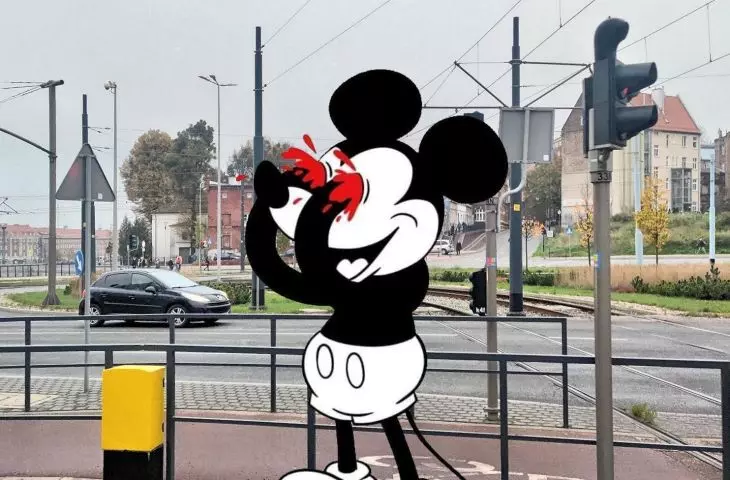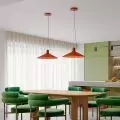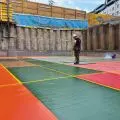I sailed into the dry expanse of ocean blue,
The suv plunges into concrete, columns it wades through.
Amid the wave of tracks, amid the flood of traction,
I bypass coral islets of obstructions.
The dusk descends, nowhere park nor beauty to be found,
I looked up to the sky, by forest of poles and cables bound.
Is that a distant glow? Is that a city encircled by transit?
And the descent into the tunnel, where one descends to hell's pit.
Let's stop! - Red. - I hear the clatter of signals.
A concrete basket, a pole, a tilted prohibition sign.
I hear the hum of tires, the clatter of horror's brakes.
Squealing, moaning, screaming of the city. A collage of grayness and yellow punctuated by screams.
Our eyes and ears bleed from the excess of engineering.
Wherever I look, a box, a plate, a cabinet greets us with a creak and a crash.
Let's go, no one calls, let's find a place that's healthy
Where greenery and pedestrians live in harmony with the city.
Oh no, we stops again. Passage through this multi-stage agony.
Call me a wave, which undercuts the legs of hope. I greet you today with this splendid uplifting message, which in this process of preliminary marination of our imagination will prepare us, (I hope), at least a little for today's study trip to the land of aesthetic technomancers.
If it sometimes occurs to you to doubt the sense of what you are doing, to think that it all doesn't make sense anyway, then think to yourself that there are such urban planners and architects in Poland, and they are trying to create. And even when a better day happens to them, one in a million, in which someone allows an urban planner to create the framework of a public space that will have some vestiges of a beautiful foundation, while an architect can add his building to this space, which will be a magnificent work of his life, thenanyway, all that effort and dispatch, all that work is like beating a dead horse, because the space will be filled by mindless warren of installation and road engineering fashioned from concrete and poor-quality items from the "Everything for dolar store". In this country, any effort to create beauty, even backed by great funds for this purpose, is immediately met with an even better-funded horde of bottomless ugliness of installation-road engineering that wipes all this effort into dust. And all this anyway, provided that the aforementioned urban planner of his own accord, alone and in an altruistic surge of heroism, decides to fight for a beauty that no one demands or expects from himno one expects from him, while the architect does not go mad and start designing himself a monument to his aesthetic delusions, in isolation from the context of his surroundings, as if the whole world ended at the border of the plot. So, yes. I know that in this Poland you can get a nervous breakdown looking for a reference to the context, but the jokes are over. Someday you have to start anyway.
Budapest before and after
Source: www.urb-i.com
Gliwice before and after
© Pawel Mrozek | Google Street View photography
So if you sometimes wonder why Polish cities are expanding in such a bottomless disgusting way, and why in photographs of cities our "after" is the same as the "before" in civilized countries, here is the whole answer to this question. Beauty is the responsibility of a small number of people from whom no one demands or expects anything and who, at best, create under conditions of a losing battle in advance. A battle for the character of a space dominated by the macabre creations of an army of engineers and civil servants for whom beauty and spatial order are at no stage a goal. For the lion's share of what is our public space is being created with public money, that is, nobody's money, brought in a suitcase from Brussels, which must be disposed of as quickly as possible in order to trumpet success. And somehow, strangely enough, the success of the spent public money does not like to go hand in hand with beauty and spatial order. For beauty and order are normality, an invisible lubricant for reality, which can move silently thanks to it, without friction and gnashing. It is very difficult to make an electoral slogan out of beauty and order. Because what would it supposedly look like? A flashing eye-popping neon sign "Hooray, look what kind of normalcy we've done to you?" or maybe an agitator roaring through a megaphone "People look how peaceful it is here?" Well it doesn't work like this.
Perhaps you can already feel, which is what I'm getting at, that one doesn't stick too well with the other. The new spaces scream grandiosity and shoddiness because they are election advertising, not something that is supposed to serve us. Yellow railings, electrical boxes across sidewalks, hydrants at pedestrian crossings at the height of young children's faces, five separate poles where one common would suffice. More, cheaper, better.
I, however, do not claim that this bumping up of space is some kind of deliberate intentional procedure. On the contrary, such a practice has been constituted in the not too distant past by an unconscious Darwinist evolutionary process, which eliminated local government officials and politicians trying to do things beautifully and modestly, and at the same time frugally, and promoted such politicians who employed aesthetically impaired bureaucrats, whose hand came up with more and more shocking and coarse creations. For the average Pole completely desensitized to beauty will never appreciate in an election the fact that someone has cleaned, washed and repaired so that you can't see. For the average Pole, in order to admire and appreciate his politician, must visually get invested in the morass so that he falls over and loses consciousness for a moment. Only this gives the politician a shadow of a chance that Mr. Kowalski, going to cross off his vote on the ballot, will so much as remember what he has to be grateful to whom for.
- Aaa Halina. Those do what they don't? Well you can't say that nothing is happening.
- Well they are doing, they are doing. You can see that things are finally changing like crazy.
Antwerp before and after
source: www.urb-i.com
Gdansk before and after
© Pawel Mrozek | Google Street View photography.
"Before" and "after" turned upside down. Aesthetics stand on their head. Welcome to the antipodes of beauty, where only ripped-for-nothing intersections and a patchwork of installation manholes and booths with a very important installation pay off. A space in Lego colors, a real Polish hygge. Acoustic screens to make it quieter for people, barriers, fences and pedestrian tunnels to make it safer for people, a kazbzylion of signs (new!!! Now also flashing with variable content) and all sorts of signs to make it clearer for people. All this backed up by the necessity of regulations, which are, after all, to make things better for people. It's just that people are better off in a space that is beautiful and consistent, but there's nothing about that in the regulations. Beauty does not have a stamp of approval for documentation in this country. Beauty is a resource that is squandered, slicing material from it into "liability shield" type of actions containing things that are ugly and often unnecessary to anyone, but which we did out of laziness, because that's what was easiest.
I was reminded of such an anecdote from real life. It was a long time ago, at least ten years ago. My friends and I went to a consultation on the design of a new street in Gdansk, which was to be the main street of a future new district in the post-shipyard areas, such a Polish HafenCity. We are discussing with the officials, the conversation focuses on why this street should be so poor, all the development pushed out the back, and the space made of the cheapest materials, like somewhere near some supermarket behind freeway. So I asked a question, which I directed to the city representative. I didn't even want to cite examples from the West anymore, because, first of all, he probably wouldn't associate, and secondly, because I would get the standard answer of "Oh lord, but Gdansk has completely different characteristics." Every official's favorite answer, allowing one to cast aside the existence of the knowledge of urban design that has been developed through the efforts of all mankind, because Gdansk is so completely unique that no known architectural and urban planning knowledge can fits our needs. But I'm smart, or at least I think I am, so I approach it differently.
- But I ask you. If you were to redesign Grunwaldzka Street today... (the main existing street in Gdansk), would you also put up noise barriers, intersections with center islands and pedestrian crossings every kilometer? - I asked slyly, rubbing my hands in the belief that I had finally managed to drive him into a corner.
- Yes.
The end. Curtain. Behold, all the artistry of road engineering as performed by city officials was sent down to me in that one moment of magnificent, erudite illumination and revealed to me in its full glory. The mask dropped, and from under it appeared the face that uttered that one word, without shame or a blink of an eye.
This is what I would do, because these are the rules. I have darned my armor with them, and even though I know that I am wrong and any investment can be done differently, only it would require me to make an effort, here I am locking myself in my fortress and try to besiege me poor man to force me to use my brain. I warn you in advance that your chances are nil, and I will fight the battle of ugliness fiercely, because this is what my superiors expect of me, and it is much easier for me than to bend to the opinion of some mortal.
Gdańsk South (Łostowice), an intimate square in the center of the district
Photo: Pawel Mrozek
Maybe the only thing he didn't expect was that ten years later he would no longer be in this position, although we continue to stand as at Troy.
O ungovernable kingdom and perdition near,
Where neither laws weigh nor justice
Has places, but everything with gold must be bought!
No matter. Yes, other than that, nothing has changed. Another five developments have cluttered up the space in a way that completely nullifies the sense and desirability of efforts to make their neighborhood more beautiful with, for example, good architecture. Fortunately, there is usually no more room for such engineering in the center, but only because everything that could be has long since been swamped with flyovers and a festival of unfettered installations, and only the murmurs of some officials about the need to demolish the city in order to widen urban highways and intersections sometimes still reach us like the murmurs of a distant (fortunately) storm. At least it's a good thing that it's no longer raining in the center and one can get down to estimating the damage.
The center of Lodz, after the successful modernization of the road system the population of trees = 0
© Google Street View
But not to pour only bitter regrets. Why in general is it so and does it have to be so? Are we in Poland doomed to hopeless engineering instead of spaces for people? Of course, the first thing that comes to mind is that car-centric space design is to blame. And that's obviously the case, although the problem is deeper than that, and I'll try to explain. That automobile-centric urban design is a major obstacle to creating beautiful cities is quite easy to prove, by the way. Imagine the desk of a lazy person who doesn't particularly like to clean on it, but has to work at it. Everything pushed to the sides, as long as it keeps space in the work area. Cups and bottles, some screwdrivers, papers, receipts, a stack of markers to play with, some cables. Everything pushed aside so it doesn't lie on the keyboard or near the mouse. The keyboard and mouse are sacred on the desk of the owner of the mess. It's the same with street design. The roadway is untouchable. All trash, poles, garbage cans, utility boxes won to the sidewalk. The fern on this desk no longer fits so won't, they stand somewhere in the park, on the windowsill preferably. Whether people will cross the sidewalk, whether an elderly person will be able to jump over the hood of a car, whether a parent with a child in a stroller will squeeze between the railing and a box with a very important installation is of secondary or even no importance, because the working area for young beautiful and motorized engineers is only the roadway. And I'm not basing this on a stereotype, there are studies that tell what social group designs our spaces and what social group has to use them. These are two very different social groups with very different needs.
Puck - a great investment gift for cyclists
Photo: Pawel Mrozek
Let's get back to the topic, however. The boss holds designers accountable for the work they do, not whether they have a tidy desk. Beautiful cities, unfortunately, do not pay their bills. If no one puts a revolver to their heads, otherwise they will never design such by themselves. And what should we, as residents, stand over them with a whip and watch over them? No. We don't even have the ability to do so. If it works like this, it means that the whole system is wrong, and we have entrusted the design of the space to the wrong people, wrongly placed in the hierarchy of the whole process. It can't be the case that the design of the most important spaces in a city, such as streets, started with a road designer and ended with an installer of underground utilities. This is not how the fabric of the cities that today are considered the most beautiful and best to live in were designed. The problem, however, does not lie in engineering per se. Engineers are just professionals in their narrow field and do the kind of projects they are entrusted with. The local and central governments, which have built a system based not on the common good and creating quality, but on raising funds and spending them quickly are to blame. If this is how we form the goals of our policies, then indeed in such a process the architect and the urban planner are just like sand shifting under the feet of officials to whom Excel must agree. And this is how the country functions today. However, if we consider that what matters to us is the quality of life, because in a beautiful space people live healthier, longer and are happier, then it turns out that our whole system of making investments and the way we develop cities makes absolutely no sense. A person is not just a machine that needs electricity, water and gas connections to function. Life is not an assembly line in a factory, to be filled only with equipment optimized by production technologists, helping us glide along that conveyor belt all the way to the final packaging and distribution point of our meat in coffins. Right? And that's what all the new settlements look like in Poland. Because it has absolutely nothing to do with the urban organism that evolved along with our species over thousands of years of our experience. If medicine worked like city planning in this country, humanity would turn into a Japanese gore and body horror movie. And yet cities are also living social organisms.
- You know. This pacemaker is now no longer sewn into the patients, but in the tender we selected a method that we attach it with a taker to your back. Ok?
- Oh great, how cool. Cheap and ingenious. I am very happy.
University campus in Gdansk - epicenter of reason and enlightenment
Photo: Pawel Mrozek
It's high time to say stop and restore the proper order of things in the creation of our living space, and it should start with changing the hierarchy in investment processes. Before we spend any zloty at all on a technical project that will enable us to pour concrete over the ground and impale all public space with a dead forest of telecommunication poles, the City Architect, together with planners and residents, must define the character of that space. But not some one, not the five most important ones chosen by drawing the wheel of fortune, but every space. Each space, in turn, is not just a system of road lanes from a spatial planning documents. A space is everything between buildings in a city, which means almost everything in general. And there can be no exceptions, because the last seventy years of our experience shows that every thing we have done with disregard for the opinion of residents and experts who know about space design makes our eyes bleading.
Gdansk - a flyover planned for renovation along a transit thoroughfare that does not exist;
the space of the intersection of Dlugy Ogrody, Podwale Przedmiejskie and Elblaska streets
Photo: Karol Spieglanin
However, working in such a way on any space may seem like a deadly impossible effort for local governments, which have so far only dealt with pushing problems to the sidewalk, but we don't have to do everything on foot. We have the achievements of civilization, good models, technical progress, and we know how to do things systemically. So that we don't reinvent the wheel with every space, we can create a catalog of urban planning codes for ourselves. Even if they don't function in central law, any local government that has the good will can enact such a thing, so that it becomes a guideline for officials preparing investments and for planners creating local zoning plans. One can also create for oneself pavement standards or urban street standards. But let me warn you right away, not like in Gdansk where idealistic typical street cross-sections with beautiful trees and sidewalks have been imagined, and which are then reflected in a whole crazy 5% of the length of such a street, because the rest is made up of swollen cocoons of intersections with gigantic center islands and a bazillion of right and left turns, which is not included in the standard. This is not how I recommend doing things. That's what you do when quality isn't the goal after all, just when you want people to get away from you.
It's also possible to create within the standards of a street or more broadly of a public space, standards for furnishing those spaces. And it's not even a matter of designing here at once what the benches and trash cans should look like, but how it should all be located. And not just small architecture, but first of all technical equipment, all installation and traffic safety elements. All those posts, railings, boxes, tubes, blocks. It is their aesthetics and the way they are located in the space that determines whether we will feel in this space like a pleasant city to live in, or like a on a tour in the steelworks.
Gdansk South (Łostowice), the center of the district
photo: Pawel Mrozek
Examples of the fact that it is possible to think about these elements when creating investments are fortunately multiplying. My favorite is Swietojanska Street in Gdynia, which, despite having been rebuilt some two decades ago, still looks much better and more European than 99% of new street renovations in this country. Finding the places where all these installations are hidden on it is a challenge for very observant people, unlike a typical Polish street, which has all these guts on the surface and is only able to hide them from a completely blind person, and that too only until he stumbles over that installations. However, it's not only Swietojanska Street, but also Piotrkowska Street in Lodz, Five Corners Square in Warsaw, Litewski Square in Lublin and so on. I could go on listing until we fall into absolute bliss, but it doesn't change the fact that the total of these wouldn't even add up to a per mille in relation to the area of our cities, which shows the enormity of the challenge we face.
Swietojanska Street in Gdynia, a rare case of Polish civilized space
Photo: Pawel Mrozek
I <3 Lublin, yes sir
photo: Pawel Mrozek
Piotrkowska street in Lodz
photo: Pawel Mrozek
And the best part at the end. Such investments are not at all much more expensive than those carried out under the "Fire up an EU grant and forget" standard. The main difference lies in the amount of design work and the intensive involvement of the local government in the process. Yes. That, among other things, is why rich Western countries are rich. Because there they don't blow off so much investment to the exclusion of honestly paid human intellectual labor. The beginnings, of course, will be difficult, even painful, and will prolong many investment processes, but over time we will get into the habit of doing this and begin to feel the benefits of economies of scale. We need to start valuing expert work instead of going for the easy way, otherwise the people of this country will also go for the easy way. Those with opportunities have already left this country and will continue to go to such countries where this respect and attention to quality is included in the "Basic" package. Hello, this is how the brain drain is created. But it doesn't have to be that way. Which path we choose will determine whether we will be a beautiful country that attracts residents with quality of life, or whether we will be a country of aging grandfathers, dashing their farts between service and human control points, in pursuit of a lost life. You can ignore this, but at some point you should realize that you are doing no one any favors, and continuing to live in such a country is a disservice to your own family, your own health and is simply dangerous. However, if you have already finally decided to die a martyr's death in this country, I have one request for you. Let's at least think about what we will die for.
Hey, this is the way.
























































